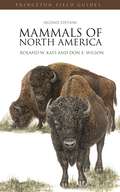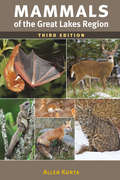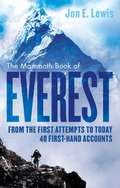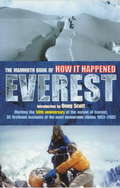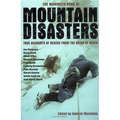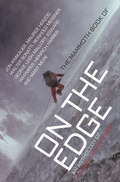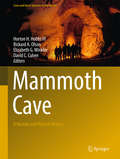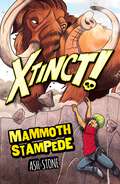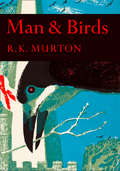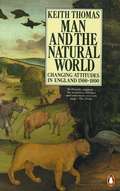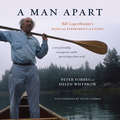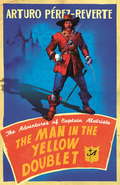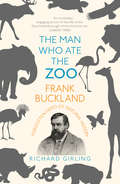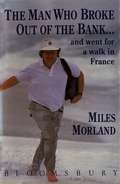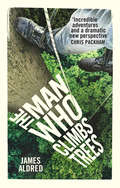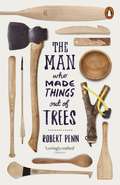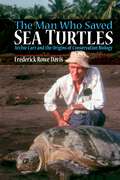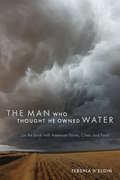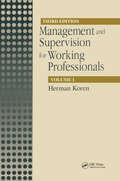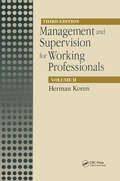- Table View
- List View
Mammals of North America: Second Edition
by Roland W. Kays Don E. WilsonThe best-selling field guide that "sets new standards" (New Scientist) and "makes all other field guides for mammals of the United States. . . and Canada obsolete" (Journal of Mammalogy) is now even better. Covering 20 species recognized since 2002 and including 13 new color plates, this fully revised edition of Mammals of North America illustrates all 462 known mammal species in the United States and Canada--each in beautiful color and accurate detail. With a more up-to-date species list than any other guide, improved facing-page descriptions, easier-to-read distribution maps, updated common and scientific names, and track and scat illustrations, this slim, light, and easy-to-use volume is the must-have source for identifying North American mammals. Roland Kays and Don Wilson have scoured the technical literature to pull out the key differences between similar species, and illustrated these whenever possible, making the guide useful to amateur naturalists and professional zoologists alike. Casual animal watchers will appreciate the overview of mammal diversity and the tips on identifying animals they can spy in their binoculars, while scientists will appreciate the exacting detail needed to distinguish similar species, including illustrations of shrew teeth, bat toes, and whale dorsal fins. The best-illustrated and easiest-to-use field guide to North American mammals Beautiful and accurate color illustrations of all 462 mammals found in the United States and Canada--including 20 species recognized since 2002 112 color plates--including 13 new ones Key identification information--fully revised--on facing pages The most current taxonomy/species list Fully revised, easy-to-read range maps Illustrations of tracks, scat, and whale and dolphin dive sequences
Mammals of the Great Lakes Region, 3rd Ed. (Great Lakes Environment)
by Allen KurtaNow in an extensively revised 3rd edition, Mammals of the Great Lakes Region has been an essential reference for countless amateur and professional naturalists since 1957. Easily tucked into a backpack and carried into the field, this heavily illustrated guidebook offers detailed information on 83 species, including each mammal’s appearance, behavior, and natural history, along with an explanation of its scientific name. Species accounts are accompanied by new color photographs plus fully updated distribution maps showing the geographic range in the Great Lakes region and in North America. A thorough introduction outlines the environmental factors that affect the distribution and abundance of mammals in Great Lakes ecosystems and discusses the impacts of current human activities, including introduction of diseases and climate change. There is also a section on preparing captured specimens for research or teaching, as well as user-friendly keys and quick reference tables to physical measurements and life history data. Brand new in this edition, the book also features detailed illustrations of the tracks of commonly found mammals to assist with year-round identification. Providing the most up-to-date information on mammals in the Great Lakes basin, this book belongs on the shelves of teachers, students, naturalists, and professional biologists throughout the region.
The Mammoth Book Of Everest: From the first attempts to today, 40 first-hand accounts (Mammoth Books #372)
by Jon E. LewisThis selection of the very best writing on Everest begins with the first attempts and continues, via Mallory's failed bid and Hillary and Tenzing's triumph, to the disasters of recent years. It features 35 white-knuckle accounts of climbing on the world's highest mountain, with all the tragedy and triumph of humankind's striving for the top of the world, by those who know the 'Death Zone' best - the climbers themselves. But this is much more than just the best of exhilarating first-hand accounts of climbing on Everest. It includes the full history of the conquest of Everest, and provides an evocative portrait of the cruel, natural beauty of Chomolungma, 'The Mother Goddess of the World'.
The Mammoth Book of How it Happened - Everest (Mammoth Books)
by Jon E. LewisBegining with the 1921 attempt on the summit of Everest through to the disasters of the 1990s, this work features 30 white-knuckle accounts of climbing endeavour on the world's highest mountain, with all the tragedy and triumph of humankind's striving for the top of the world, by those who know the "Death Zone" best - the climbers of Everest themselves. Yet this is more than a cherry-picking of great true and exhilarating memoirs of Everest. Included are the history of the conquest of Everest, and all the natural and cruel beauty of Chomolungma "The Mother Goddess of the World".
The Mammoth Book of Mountain Disasters (Mammoth Books)
by Hamish MacInnesCaught way up on the mountain, no one is safe, from the archetypal nightmare of Tony Kurtz, seen to freeze to death by his stranded rescuers as he hung off the Eiger, to events that unfolded on the Grand Teton, where rescuers narrowly escaped being clubbed to death by their reluctant rescuees. This collection of 35 first-hand accounts will shock and inspire in equal measure. Here is the original draft of Joe Simpson's classic Touching the Void and the first full telling of Jamie Andrew's extraordinary rescue from the Alps, which made headlines in 1999. Plus a specially commissioned account of the epic winter rescue on Mount Ararat, 2000 - the most remote mission ever undertaken by a helicopter-rescue team. And the rescuers own grim battles for survival.Compiled by one of the world's most respected mountaineers, this volume spans five continents - from the Appalachians to Mount Cook, from Peak Lenin to Siula Grande. It includes some of the brightest stars of mountaineering and mountain rescue: Joe Simpson, Doug Scott, Pete Sinclair, Milos Vrbe, Paul Nunn, Ludwig Gramminger, Karen Glazley, Ken Phillips and Blaise Agresti.
The Mammoth Book of On The Edge (Mammoth Books)
by Jon E. LewisNo one sees clearer than an individual whose life is hanging by the finger tips on the edge of an abyss. Probing the furthest reaches of human daring and endurance, here are 28 of the great first-hand accounts of extreme mountaineering, from legendary names. Featuring:·Heinrich Harrer - first conqueror of the notorious Eigerwand.·Robert Bates - the classic account of the ill-fated American 1953 expedition to K2.·Maurice Herzog - his unstoppable ascent of Annapurna at the cost of frostbite.·Walter Bonatti - tragedy on the Central Pillar of Freney on Mont Blanc.·George Leigh Mallory - surviving an avalanche on the 1922 Everest expedition.·René Desmaison - his epic story of 14 days stuck on The Grandes Jorasses in winter.·Jon Krakauer - recalling his solo ascent of The Devil's Thumb in Alaska.The price of the summit is often measured in human suffering, yet for those who succeed the rewards can be incalculable. Nerve-wracking and unputdownable.
Mammoth Cave: A Human and Natural History (Cave and Karst Systems of the World)
by Horton H. Hobbs III Rickard A Olson Elizabeth G Winkler David C. CulverThis book reveals the science and beauty of Mammoth Cave, the world's longest cave, which has played an important role in the natural sciences. It offers a comprehensive and interdisciplinary treatment of the cave, combining insights from leading experts in fields ranging from archeology and cultural history to life science and geosciences. The first animals specialized for cave life in North America, including beetles, spiders, crayfish, and fish, were discovered in Mammoth Cave in the 1840s. It has also been used and explored by humans, including Native Americans, who mined its sulfate minerals and later African-American slaves, who made a map of the cave. More recent stories include 'wars' between commercial cave owners, epic exploration trips by modern cave explorers, and of course tourism.The first section of the book is an extensive description including maps and photos of the cave, its basic structural pattern, and how it relates to the surface landscape. The second section covers the human history of utilization and exploration of the cave, including mining, tourism, and medical experiments. Cave science is the topic of the third section, including geology, hydrology, mineralogy, climatology, paleontology, ecology, biodiversity, and microbiology. The fourth section looks to the future, with an overview of environmental issues facing Mammoth Cave managers.The book is intended for anyone interested in caves in general and Mammoth Cave in particular, experts in one discipline seeking information about other areas, and researchers and students interested in the many avenues of pursuit possible in Mammoth Cave.
Mammoth Stampede: Book 4 (Xtinct! #4)
by Ash StoneA giant woolly mammoth comes back to life in this action-packed adventure story.Time is running out! Barron Fox's hunting lodge is opening soon, and Jeevan discovers that he's planning a very big surprise for his guests - a woolly mammoth, brought back to life for them to hunt!If the lodge opens, the animals in the forest will be in danger too. Can Jeevan and his friends launch a daring rescue mission that tramples over Fox's plans?Perfect for fans of Beast Quest, Deadly 60 and Jurassic Park, these action-packed adventures will inspire readers to help save endangered species and combat extinction.
Man and Birds (Collins New Naturalist Library #51)
by R. K. MurtonHere is a fascinating and authoritative survey of the complex inter-relationships of bird and human life in this country.
Man and the Natural World: Changing Attitudes in England 1500-1800 (Penguin History Ser.)
by Keith Thomas'Man and the Natural World, an encyclopaedic study of man's relationship to animals and plants, is completely engrossing ... It explains everything - why we eat what we do, why we plant this and not that, why we keep pets, why we like some animals and not others, why we kill the things we kill and love the things we love ... It is often a funny book and one to read again and again' Paul Theroux, Sunday Times 'The English historian Keith Thomas has revealed modes of thought and ways of life deeply strange to us' Hilary Mantel, New York Review of Books'A treasury of unusual historical anecdote ... a delight to read and a pleasure to own' Auberon Waugh, Sunday Telegraph'A dense and rich work ... the return to the grass roots of our own environmental convictions is made by the most enchantingly minor paths' Ronald Blythe, Guardian
A Man Apart: Bill Coperthwaite’s Radical Experiment in Living
by Peter Forbes Helen WhybrowA story of friendship, encouragement, and the quest to design a better world A Man Apart is the story—part family memoir and part biography—of Peter Forbes and Helen Whybrow’s longtime friendship with Bill Coperthwaite (A Handmade Life), whose unusual life and fierce ideals helped them examine and understand their own. Coperthwaite inspired many by living close to nature and in opposition to contemporary society, and was often compared to Henry David Thoreau. Much like Helen and Scott Nearing, who were his friends and mentors, Coperthwaite led a 55-year-long “experiment in living” on a remote stretch of Maine coast. There he created a homestead of wooden, multistoried yurts, a form of architecture for which he was known around the world. Coperthwaite also embodied a philosophy that he called “democratic living,” which was about empowering all people to have agency over their lives in order to create a better community. The central question of Coperthwaite’s life was, “How can I live according to what I believe?” In this intimate and honest account—framed by Coperthwaite’s sudden death and brought alive through the month-long adventure of building with him what would turn out to be his last yurt—Forbes and Whybrow explore the timeless lessons of Coperthwaite’s experiment in intentional living and self-reliance. They also reveal an important story about the power and complexities of mentorship: the opening of one’s life to someone else to learn together, and carrying on in that person’s physical absence. While mourning Coperthwaite’s death and coming to understand the real meaning of his life and how it endures through their own, Forbes and Whybrow craft a story that reveals why it’s important to seek direct experience, to be drawn to beauty and simplicity, to create rather than critique, and to encourage others.
The Man In The Yellow Doublet: The Adventures Of Captain Alatriste (The Adventures of Captain Alatriste)
by Arturo Perez-ReverteCaptain Alatriste returns in a swashbuckling tale of intrigue, romance and regicide.Captain Alatriste's affair with the beautiful actress Maria de Castro is rankling not only his long-term mistress but also the King of Spain. With loyal companion Inigo distracted by the affections of Angelica, Alatriste becomes embroiled in a series of tussles outside his lover's house. Ambushed by arch-nemesis Malatesta, a skirmish ensues that leads to the death of Maria's other lover - the monarch himself. But behind this tale of sexual jealousy lurks a darker truth. As it becomes clear that both Alatriste and Inigo have been cunningly honey trapped - and that the dead man was an impostor. With a puppet king waiting dutifully in the wings, Alatriste must use all his cunning and swordsmanly guile to prevent the murder of the real king - and his implication in a crime for which he has been perfectly framed.
The Man Who Ate the Zoo: Frank Buckland, forgotten hero of natural history
by Richard GirlingFrank Buckland was an extraordinary man – surgeon, natural historian, popular lecturer, bestselling writer, museum curator, and a conservationist before the concept even existed. Eccentric, revolutionary, prolific, he was one of the nineteenth century’s most improbable geniuses. His lifelong passion was to discover new ways to feed the hungry. Rhinoceros, crocodile, puppy-dog, giraffe, kangaroo, bear and panther all had their chance to impress, but what finally - and, eventually, fatally - obsessed him was fish. Forgotten now, he was one of the most original, far-sighted and influential natural scientists of his time, held as high in public esteem as his great philosophical enemy, Charles Darwin.
The Man Who Broke Out of the Bank and Went for a Walk across France
by Miles MorlandAt the age of 45 Miles Morland resigned from his highly paid job as head of the UK division of a major American bank and went for a walk with his wife in France. Neither of them was used to walking further than the distance between a restaurant and a waiting taxi. They walked from the Mediterranean to the Atlantic, 350 miles through the foothills of the Pyrenees, staying in small country inns and occasionally sleeping out along the way. The author describes the pleasures and agonies of the walk and reflects frequently and with relief on the life from which he has escaped. The pressures of his former life had affected him in many ways, the repercussions including divorce and then remarriage to his former wife Guislaine.
The Man Who Climbs Trees
by James Aldred'A book of heart-stopping bravery and endurance' -- Helen Macdonald'A great read – incredible adventures and a dramatic new perspective' -- Chris Packham'[A] delightful, endlessly fascinating book' -- Daily Mail BOOK OF THE WEEKThis is the story of a professional British tree climber, cameraman and adventurer, who has made a career out of travelling the world, filming wildlife for the BBC and climbing trees with people like David Attenborough, Chris Packham and Helen Macdonald.James's climbs take him to breathtaking locations as he scales the most incredible and majestic trees on the planet. On the way he meets native tribes, gets attacked by African bees, climbs alongside gorillas, chased by elephants, and spends his nights in a hammock pitched high in the branches with only the stars above him.This book blends incredible stories of scrapes and bruises in the branches with a new way of looking at life high above the daily grind, up into the canopy of the forest.
The Man Who Loved Siberia
by Roy Jacobsen Anneliese PitzSiberia, to me, is a fairy-tale land.Fritz Dörries set out on his first trip to Eastern Siberia in 1877, when there were still blank spaces on maps of the world. Travelling alone or with his brothers, he climbed mountains, traversed great rivers, explored remote islands and crossed treacherous lakes of ice, always with one purpose: to augment man's knowledge of the natural world. Bears, tigers, vipers, bandits, stormy seas, frostbite, ice chasms fathoms deep - every danger was faced head on and overcome. And yet he remained defenceless against the charms of the landscape, and the animals, birds and butterflies he found there.Through his twenty-two years in Siberia, Dörries collected a wealth of essential material for scientific institutions, fundamental to our understanding of fauna and flora. This account of his adventures, set down for his daughters in his ninetieth year, and adapted for publication by Roy Jacobsen and Anneliese Pitz, is his second great legacy.Translated from the Norwegian by Seán Kinsella
The Man Who Made Things Out of Trees: The Ash In Human Culture And History
by Robert PennRobert Penn cut down an ash tree to see how many things could be made from it. After all, ash is the tree we have made the greatest and most varied use of over the course of human history. Journeying from Wales across Europe and Ireland to the USA, Robert finds that the ancient skills and knowledge of the properties of ash, developed over millennia making wheels and arrows, furniture and baseball bats, are far from dead. The book chronicles how the urge to understand and appreciate trees still runs through us all like grain through wood.
The Man Who Saved Sea Turtles: Archie Carr and the Origins of Conservation Biology
by Frederick DavisArchie Carr, one of the greatest biologists of the twentieth century, played a leading part in finding a new and critical role for natural history and systematics in a post-1950s world dominated by the glamorous science of molecular biology. With the rise of molecular biology came a growing popular awareness of species extinction. Carr championed endangered sea turtles, and his work reflects major shifts in the study of ecology and evolution. A gifted nature writer, his books on the natural history of sea turtles and their habitats in Florida, the Caribbean, and Africa entertained and educated a wide audience. Carr's conservation ethic grew from his field work as well as his friendships with the fishermen who supplied him with many of the stories he retold so engagingly. With Archie Carr as the focus, The Man Who Saved Sea Turtles explores the evolution of the naturalist tradition, biology, and conservation during the twentieth century.
The Man Who Saved Sea Turtles: Archie Carr and the Origins of Conservation Biology
by Frederick DavisArchie Carr, one of the greatest biologists of the twentieth century, played a leading part in finding a new and critical role for natural history and systematics in a post-1950s world dominated by the glamorous science of molecular biology. With the rise of molecular biology came a growing popular awareness of species extinction. Carr championed endangered sea turtles, and his work reflects major shifts in the study of ecology and evolution. A gifted nature writer, his books on the natural history of sea turtles and their habitats in Florida, the Caribbean, and Africa entertained and educated a wide audience. Carr's conservation ethic grew from his field work as well as his friendships with the fishermen who supplied him with many of the stories he retold so engagingly. With Archie Carr as the focus, The Man Who Saved Sea Turtles explores the evolution of the naturalist tradition, biology, and conservation during the twentieth century.
The Man Who Thought He Owned Water: On the Brink with American Farms, Cities, and Food
by Tershia d'ElginThe Man Who Thought He Owned Water is author Tershia d’Elgin’s fresh take on the gravest challenge of our time—how to support urbanization without killing ourselves in the process. The gritty story of her family’s experience with water rights on its Colorado farm provides essential background about American farms, food, and water administration in the West in the context of growing cities and climate change. Enchanting and informative, The Man Who Thought He Owned Water is an appeal for urban-rural cooperation over water and resiliency. When her father bought his farm—Big Bend Station—he also bought the ample water rights associated with the land and the South Platte River, confident that he had secured the necessary resources for a successful endeavor. Yet water immediately proved fickle, hard to defend, and sometimes dangerous. Eventually those rights were curtailed without compensation. Through her family’s story, d’Elgin dramatically frames the personal-scale implications of water competition, revealing how water deals, infrastructure, transport, and management create economic growth but also sever human connections to Earth’s most vital resource. She shows how water flows to cities at the expense of American-grown food, as rural land turns to desert, wildlife starves, the environment degrades, and climate change intensifies. Depicting deep love, obsession, and breathtaking landscape, The Man Who Thought He Owned Water is an impassioned call to rebalance our relationship with water. It will be of great interest to anyone seeking to understand the complex forces affecting water resources, food supply, food security, and biodiversity in America.
Management and Development of Agricultural and Natural Resources in Egypt's Desert (Springer Water)
by Ahmed A. Elkhouly Abdelazim NegmThis book reviews the economic potential of various natural resources found in the Egyptian deserts that could help fill the food gap in Egypt, e.g., the date palm, olives, and domestic animals. Bearing in mind that the entire country is subject to arid or hyperarid climatic conditions, only a small portion (3% of total area) is agriculturally productive in comparison, the dominant deserts. These aspects, combined with a growing population (ca. 100 million citizens) and water resources scarcity, have produced severe adverse effects on natural resource utilization. This book presents innovative methods for addressing desert soil's key problems (soil erosion, salinity, pollution, decreased fertility, minerals, and weed and pest control). Its goal is to help authorities reclaim the desert and optimally utilize the minerals and the available natural resources to support the sustainability agenda 2030. Besides, it offers researchers guidance on remaining gaps and future research directions. Lastly and importantly, it provides essential information on investment opportunities in desert cultivation, such as the fields of food, fodder, and medicinal plants.
Management and Supervision for Working Professionals, Third Edition, Volume I
by Herman KorenThe practical set of methods and tools contained in the two volumes of Management and Supervision for Working Professionals provides the reader with the knowledge and means to become an effective manager or supervisor. Volume I emphasizes organizational structure, planning, and leadership, while Volume II emphasizes communication, instruction, and daily management responsibilities such as performance ratings, unions, and health and safety.
Management and Supervision for Working Professionals, Third Edition, Volume I
by Herman KorenThe practical set of methods and tools contained in the two volumes of Management and Supervision for Working Professionals provides the reader with the knowledge and means to become an effective manager or supervisor. Volume I emphasizes organizational structure, planning, and leadership, while Volume II emphasizes communication, instruction, and daily management responsibilities such as performance ratings, unions, and health and safety.
Management and Supervision for Working Professionals, Third Edition, Volume II
by Herman KorenThe practical set of methods and tools contained in the two volumes of Management and Supervision for Working Professionals provides the reader with the knowledge and means to become an effective manager or supervisor. Volume I emphasizes organizational structure, planning, and leadership, while Volume II emphasizes communication, instruction, and daily management responsibilities such as performance ratings, unions, and health and safety.
Management and Supervision for Working Professionals, Third Edition, Volume II
by Herman KorenThe practical set of methods and tools contained in the two volumes of Management and Supervision for Working Professionals provides the reader with the knowledge and means to become an effective manager or supervisor. Volume I emphasizes organizational structure, planning, and leadership, while Volume II emphasizes communication, instruction, and daily management responsibilities such as performance ratings, unions, and health and safety.
